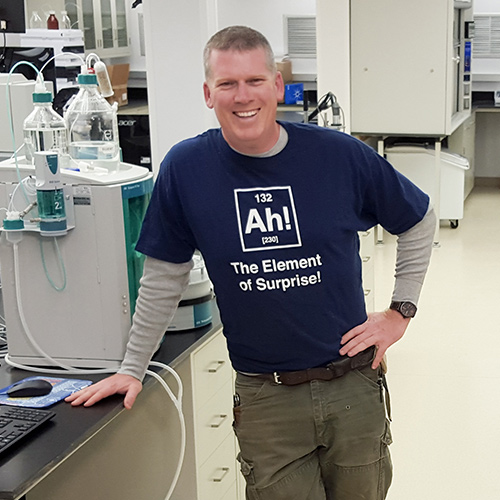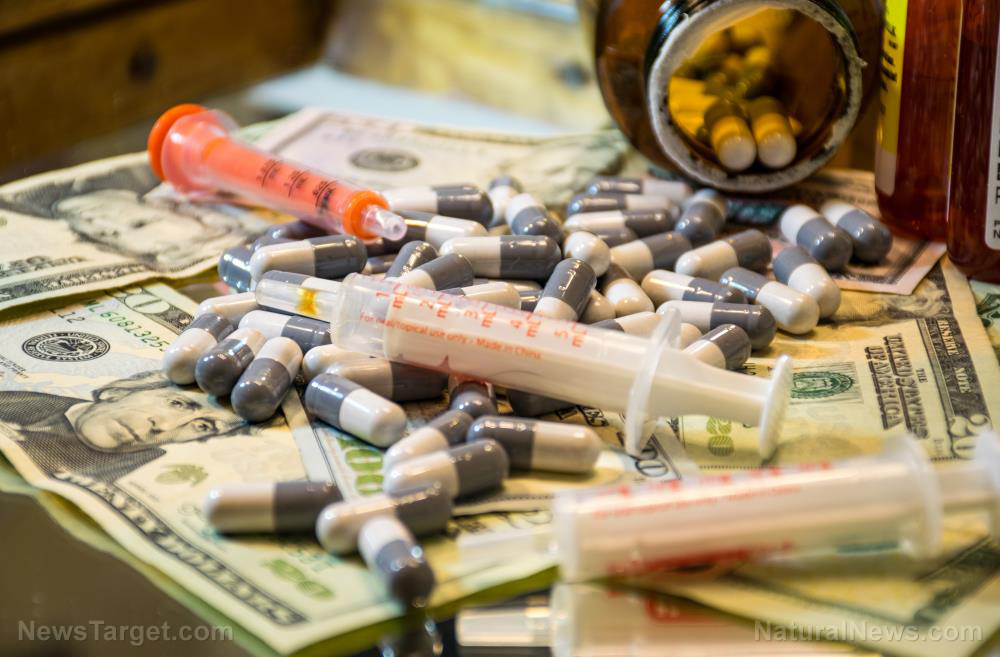
But if you've been reading Natural News for long, you already knew all this. I've been sounding the alarm on Big Pharma drug cartels for over 15 years, calling for criminal prosecutions of the pharmaceutical giants under existing racketeering (RICO) laws. The pharmaceutical drug industry is, of course, a massive criminal cartel that's steeped in bribery, fraud, predatory tactics and the systematic abuse of human lives for profit.
Now, thanks to the opioid epidemic, much of the world is finally starting to awaken to what I saw over a decade ago. The opioid epidemic has brought the criminality, corruption and pure evil of the pharmaceutical industry to light. People are downright horrified at what they're suddenly coming to realize: The pharmaceutical industry exists solely to profit from human suffering in the name of "medicine." And it doesn't matter how many lives they destroy in the process as long as their profits keep rolling in.
Health Ranger warnings about Big Pharma starting to become universally recognized
Two days ago, an astonishing article that highlights many of the same points I've made over the last fifteen years was posted by Lynn Parramore of the Institute for New Economic Thinking. This article, entitled “Worse Than Big Tobacco”: How Big Pharma Fuels the Opioid Epidemic, might as well be called, "Everything the Health Ranger warned you about Big Pharma has just come true."
Indeed, in this excellent piece of genuine journalism, Parramore repeats many of the very same points I mentioned a decade ago on Natural News, back when anyone daring to suggest that drug companies weren't God's gift to humankind was smeared, defamed and ridiculed. Now, it seems, the tide is turning against Big Pharma, and it's the opioid epidemic that's exposing the real monster lurking underneath all the fraudulent science, FDA corruption and industry influence over the (fake news) mainstream media. As I've written many times before, Big Pharma is an economic wrecking crew, and if we don't expose and dismantle its criminal racket, it will economically destroy this nation while poisoning millions of its citizens to death.
Now, I invite you to read almost everything I've been saying about Big Pharma over the last ten years, but in the words of Lynn Parramore, the Senior Research Analyst for the Institute for New Economic Thinking. I'm reprinting part of her article here, and I encourage you to read her full article at this link. In it, you will hear repeated echoes of Natural News and the warnings we've been sounding for a decade and a half.
As a side note, Lynn is a progressive writer who also writes for the Huffington Post, Alternet and other similar outlets that have desperately mocked Natural News over the years for daring to suggest exactly what Lynn Parramore is saying today. Parramore was just getting her doctorate degree from New York University when I was trailblazing awareness about Big Pharma's criminal behavior back in 2007. What's especially interesting in all this is how Lynn and I both arrive at nearly the identical conclusion about Big Pharma's serial abuse, even though we arrive at that conclusion from different worldviews.
It's also worth noting that the Republican establishment is almost universally in favor of continuing the current Big Pharma monopolies, which is one more reason why every concerned American should overthrow the status quo (at the ballot box, of course) and demand an entirely new approach to medicine that ends corporate monopolies and recognizes the value of decentralized, non-monopolized natural medicine. As I've said many times, President Trump can "reform" the health care system all he wants, but until we stop handing over one-fourth of our economy to an industry that primarily invents new ways to drug everybody for profit, we will never be able to make health care truly affordable (or effective, for that matter).
Here's part of the article from Lynn Parramore. It's worth a serious read, and if you like it, you should check out a far more exhaustive exploration of all this by reading Natural News on a regular basis.
Once again, an out-of-control industry is threatening public health on a mammoth scale
Article by Lynn Parramore, Ineteconomics.org
Over a 40-year career, Philadelphia attorney Daniel Berger has obtained millions in settlements for investors and consumers hurt by a rogues’ gallery of corporate wrongdoers, from Exxon to R.J. Reynolds Tobacco. But when it comes to what America’s prescription drug makers have done to drive one of the ghastliest addiction crises in the country’s history, he confesses amazement.
“I used to think that there was nothing more reprehensible than what the tobacco industry did in suppressing what it knew about the adverse effects of an addictive and dangerous product,” says Berger. “But I was wrong. The drug makers are worse than Big Tobacco.”
The U.S. prescription drug industry has opened a new frontier in public havoc, manipulating markets and deceptively marketing opioid drugs that are known to addict and even kill. It’s a national emergency that claims 90 lives per day. Berger lays much of the blame at the feet of companies that have played every dirty trick imaginable to convince doctors to overprescribe medication that can transform fresh-faced teens and mild-mannered adults into zombified junkies.
So how have they gotten away with it?
A Market for Lies
The prescription drug industry is a strange beast, born of perverse thinking about markets and economics, explains Berger. In a normal market, you shop around to find the best price and quality on something you want or need—a toaster, a new car. Businesses then compete to supply what you’re looking for. You’ve got choices: If the price is too high, you refuse to buy, or you wait until the market offers something better. It’s the supposed beauty of supply and demand.
But the prescription drug “market” operates nothing like that. Drug makers game the patent and regulatory systems to create monopolies over every single one of their products. Berger explains that when drug makers get patent approval for brand-name pharmaceuticals, the patents create market exclusivity for those products—protecting them from competition from both generics and brand-name drugs that treat the same condition. The manufacturers can now exploit their monopoly positions, created by the patents, by marketing their drugs for conditions for which they never got regulatory approval. This dramatically increases sales. They can also charge very high prices because if you’re in pain or dying, you’ll pay virtually anything.
Using all these tricks, opioid manufacturers have been able to exploit the public and have created a whole new generation of desperate addicts. They monopolize their products and then, as Berger puts it, “market the hell out of them for unapproved and dangerous uses.”
Opioids are a drug class that includes opium derivatives like heroin (introduced by German drug maker Bayer in 1898), synthetics like fentanyl, and prescription painkillers like oxycodone (brand name: OxyContin). A number of factors are aggravating the addiction crisis: There has been a movement in medicine to treat pain more aggressively, while at the same time wide-ranging economic distress has generated a desire to escape a dismal reality. But a key driving force is doctors—who have been wooed by pharmaceutical marketing reps—overprescribing for chronic pain.
“For the first time since the years after heroin was invented,” writes investigative journalist Sam Quinones in Dreamland: The True Tale of America’s Opiate Epidemic, “the root of the scourge was not some street gang or drug mafia but doctors and drug companies.”
Doctors were once reluctant to write prescriptions for opioids. The U.S. drug regulator, the Food and Drug Administration (FDA), would only approve such drugs for severe cases like cancer patients in chronic agony or certain people in short-term pain after, say, an operation. But representatives of Connecticut-based drug maker Purdue, which released OxyContin in 1996, along with other companies, began to flood doctors’ offices with reports asserting that using the drug for off-label purposes was harmless. Often the targets were primary care physicians with little training in addiction. Have a chronic arthritis case? Give your patient OxyContin. Tell folks take it every day, for weeks, even years, to treat just about any kind of chronic pain. The upshot was addiction —typically not because people were getting high for fun, but because they used a legal drug in precisely the way the doctor ordered.
Purdue and others whisked doctors to stylish retreats to push them to prescribe drugs for uses not approved by U.S. regulators—a marketing strategy banned by federal law. They even created fake grassroots organizations to make it seem as though patients were demanding more prescriptions. Pharmaceutical companies like to dodge responsibility for the opioid crisis by blaming dishonest distributors and pointing out that they’re not the ones prescribing or handing out drugs to patients. True enough: They don’t need to, because they’ve done their work hooking you long before the drug is in your hands.
“The marketing is not only fraudulent; it’s incredibly elaborate,” says Berger. “Fake scientific studies promote the lie that opioids are better than other medications for pain. They’ve gone to just about any length. Bribery, you name it. It’s outrageous.”
OxyContin is so addictive that it can create physical dependency in a matter of weeks. As drug makers and doctors who began to dole out pills by the handful in pain clinics learned, addicts do not behave like ordinary consumers. They don’t “choose” to buy or to wait until next week. They need their drug right away and will do anything to get it because if they don’t, they will suffer excruciating symptoms.
A Los Angeles Times report shows that among the lies Purdue spread about OxyContin was that one pill subdued pain for twelve hours. Except that for many patients it wears off much sooner, exposing them to horrific pain and withdrawal. Purdue knew this, but feared lower sales if it admitted the truth. So sales reps advised doctors to just give stronger doses, which increased the addiction risk.
As the money from hooked patients piled up, so did the bodies. So many bodies that earlier this year the Ohio Coroner’s Office found nowhere to store them.
In 2007, Purdue pleaded guilty in federal court in Virginia to misleading doctors and patients about OxyContin’s safety and paid a $600 million fine. But that sum was hardly an annoyance. From 1995 to 2015, Purdue made $35 billion from OxyContin sales alone. The Sacklers, who own the company, are now one of the richest families in America, as revealed by this triumphant Forbes spread. They know that lax regulation keeps the heat off, and that even litigation and criminal prosecutions can do little to stop them. Berger says that until such legal programs are massive in scale and scope, companies will go on with business as usual.
“We have to have injunctive relief [a court order to stop a behavior] that bans the marketing to doctors of opioids completely for unapproved uses, as well as an expansion of the FDA and DEA [Drug Enforcement Agency] to specifically target the drugs,” says Berger. His law firm, Berger & Montague, is involved in the effort to seek relief for the city of Philadelphia, which has seen above-average opioid prescribing and suffered the highest rates of fatal drug overdoses in the state last year.
Even though prescriptions have been slightly reduced across the country since 2012, Philadelphia is finding out what happens to many people hooked on opioids when they can’t get a prescription or find the price too high: They turn to smack. Fatal overdoses of heroin, oxycodone’s close cousin, have been skyrocketing since 2007 across the country.
“Landscapes of Despair”
The opium poppy has been part of human history since at least 3,400 B.C. when it was cultivated in Mesopotamia as the “joy plant.” Derivates, such as laudanum and morphine, offered more convenient and, people wrongly believed, safer ways to get the plant’s benefits. Bayer originally touted heroin as a non-addictive substitute for morphine, even for children, until it was outlawed in the U.S. in 1925. Rendering it illegal did not stop it from destroying the lives of many of America’s most celebrated artists, from Billie Holiday to Philip Seymour Hoffman.
Drug overdoses now kill more people than gun homicides and car crashes combined. In 2015, nearly two-thirds of all overdoses had one thing in common: opioids. As more and more names appear in the obituaries linked to opioid overdoses, most recently Buddhist teacher Michael Stone, Americans begin to wonder who is next.
Syracuse University’s Shannon Monnat, a sociologist focused on rural issues and an INET grantee, has been studying the epidemic and how it impacts various populations. Her research reveals that the rise in drug-induced deaths has been especially sharp among middle-aged people (45-55), with prescription opioid overdoses increasingly impacting both middle-aged and older populations. Heroin, whose sedating and euphoric effects are very similar to prescription opioids, looks to be the culprit in more young adult overdoses.
Monnat considers how the opioid crisis points to bigger societal problems impacting the economy, educational institutions, the health care system, political systems, and communities. Her work centers on investigating the characteristics of what she calls “landscapes of despair”—places where people are hurting economically and socially, like Appalachia, the Industrial Midwest, and parts of New England. She points out that persistent disadvantage and long-term poverty are clearly connected to the opioid crisis, noting that many of the areas most impacted were once robust centers of manufacturing before jobs moved to other countries.
Opioid addiction seems to thrive in downwardly mobile small cities in rural areas—but not all of them. “What’s fascinating is that some of these areas have very high mortality rates from drug overdose, like Appalachia,” say Monnat. “But others, like the Southern “Black Belt” [a region which stretches across Alabama and Mississippi], have not seen such rises.”
Originally named for its rich, dark, soil—which attracted cotton planters in the 19th century—the Black Belt has a large African American population. The area has a history of unremitting poverty, low incomes, high unemployment, and high mortality. Yet despite many hardships, which are linked the legacy of slavery, Monnat says that the region is also distinct for its “very tight-knit communities, strong kinship networks, and other networks where people can find emotional support.” It seems that when people have somewhere to turn in hard times, they may build up immunity to an epidemic like the opioid scourge.
Ironically, another factor that may have protected these communities is prejudice, as Quinones discusses in Dreamland. The low-profile heroin dealers originating from a small municipality on Mexico’s west coast who are associated with the current opioid scourge have tended to fear black Americans, preferring to target white communities. They also avoid big cities where large cartels are already established. So small, predominately white towns are their sweet spot.
Appalachia is known for kinship networks, but it also has a legacy of isolation and an outlaw tradition associated with the history of moonshining and bootlegging which can feed into today’s underground selling and distribution of opioid drugs. In this region, much of the struggling white working class has experienced economic distress with little hope of relief from America’s political system. Democrats often openly disdain “rednecks” and “hillbillies” while concentrating on identity politics rather than economic hardship. Republicans promote policies of free trade and deregulation that cast the region further into destitution.
Monnat has found that counties with large numbers of people employed in physical labor—especially occupations with higher rates of disability—have higher rates of drug fatalities. These are places where coal miners work in backbreaking positions and military veterans suffer the pain of injuries. She observes that drug companies have besieged these areas with aggressive marketing of pain pills. “In Appalachia, you’d see mining companies with physicians on staff prescribing opioids to keep people in pain working,” she says. “That was happening before OxyContin, but companies like Purdue targeted these communities to push OxyContin as a safer alternative to other pain medications.”
The National Institutes of Health (NIH) report that the opioid epidemic, which started as a regional crisis, is now a national crisis. It casts a pall over far more than individual lives; it is now decimating communities and even helping to reshape the American political landscape. Monnat finds a relationship between the landscapes of despair and the 2016 presidential election. Voting patterns show that areas in which President Trump did better than expected, like Pennsylvania and Ohio, were also places where opioid overdoses and deaths from alcohol and suicide occurred at high rates over the past decade.
During his campaign, Trump expressed concern for people in regions like Appalachia and flung stinging barbs at the politicians who had failed them. These voters supported him in high numbers, and yet sadly, his policies will likely give more power to the pharmaceutical companies that have turned their suffering into stock windfalls.
Continue reading the full article at Ineteconomics.org. Also follow more news on opioids at Opioids.news.

Mike Adams (aka the "Health Ranger") is the founding editor of NaturalNews.com, a best selling author (#1 best selling science book on Amazon.com called "Food Forensics"), an environmental scientist, a patent holder for a cesium radioactive isotope elimination invention, a multiple award winner for outstanding journalism, a science news publisher and influential commentator on topics ranging from science and medicine to culture and politics.
Mike Adams also serves as the lab science director of an internationally accredited (ISO 17025) analytical laboratory known as CWC Labs. There, he was awarded a Certificate of Excellence for achieving extremely high accuracy in the analysis of toxic elements in unknown water samples using ICP-MS instrumentation.
In his laboratory research, Adams has made numerous food safety breakthroughs such as revealing rice protein products imported from Asia to be contaminated with toxic heavy metals like lead, cadmium and tungsten. Adams was the first food science researcher to document high levels of tungsten in superfoods. He also discovered over 11 ppm lead in imported mangosteen powder, and led an industry-wide voluntary agreement to limit heavy metals in rice protein products.
Adams has also helped defend the rights of home gardeners and protect the medical freedom rights of parents. Adams is widely recognized to have made a remarkable global impact on issues like GMOs, vaccines, nutrition therapies, human consciousness.
Please contact us for more information.























